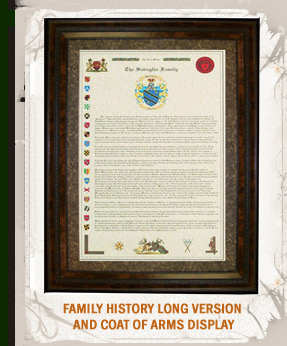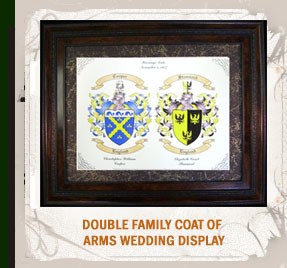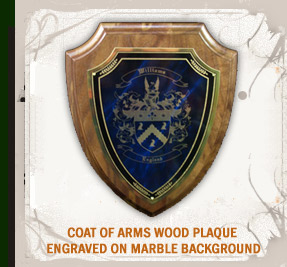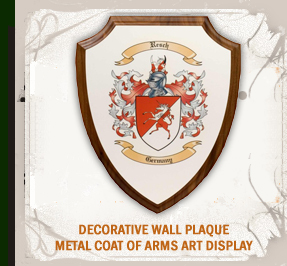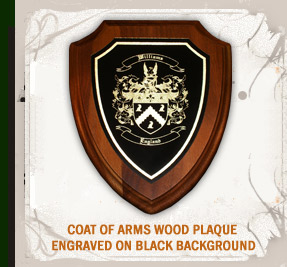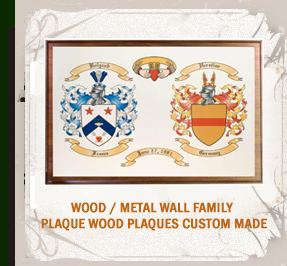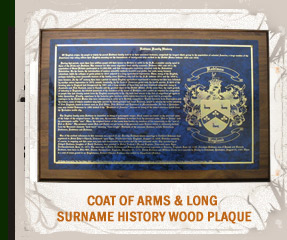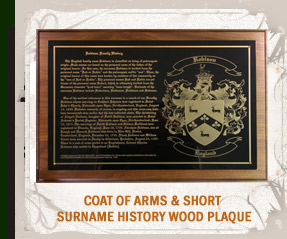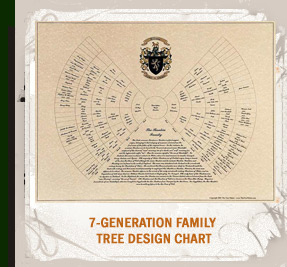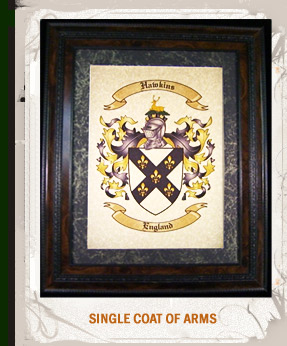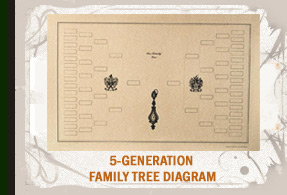Display your Spanish coat of arms or your Spain heritage
Early
Spanish Settlements: The prehistoric inhabitants of northern
Spain were cave dwellers who lived by hunting wild animals. Deep
in the caves they painted marvelous pictures of these animals on
the rock walls. The people call Iberians, who originally came from
Africa, were probably the earliest invaders of the peninsula. They
were working silver mines in the south when Phoenician traders reached
the Atlantic coast about 1100 B.C. The Phoenicians founded a trading
post called Gabir, which later became the port of Cadiz, and they
settled along the southern part of the Mediterranean coast.
The
Greeks founded colonies farther north. Another people, the Celts,
entered the land from the north and mingled with the Iberians. Next
came the Carthaginians. They took over the Mediterranean coastal
regions, but they did not go very far inland.
The
Roman Conquest of Spain: The Romans were drawn into Spain
during their wars with Carthage, and about 200 B.C. they set up
two provinces in Spain. For two hundred years they slowly spread
Roman authority and Roman speech across the peninsula. They made
laws, built roads, worked the mines, and established centers of
trade and commerce. Roman legions garrisoned the country, but in
time only a few soldiers were needed to keep order. Spain, or Hispania,
had become Romanized.
The
Visigoths of Spain: As the Roman Empire began to break
up, migrating Germanic tribes pressed into Spain. Toward the end
of the fifth century A.D., the Visigoths made themselves masters
of the country. They were Christians of the Arian sect, while the
Spanish people had accepted orthodox Christianity. The Visigoths
were fighting men who were not interested in commerce, trade, or
learning. They ruled Spain, but they did not impose their ways on
the conquered Spanish people or mix with them. Eventually the Visigoth
king decided to abandon the Arian faith, and all Spain gave allegiance
to the Church of Rome.
The
Moors of Spain: The Visigoths were succeeded by Arab and
Berber invades, called Moors, from North Africa. These Moslem people
crossed the Strait of Gibraltar in 711 and slowly pushed the Christians
back toward the mountains of the north and northwest. The Moorish
occupation of Spain lasted until 1492, and it influenced Spanish
life deeply. During the centuries of Moorish rule, most of Europe
was in the Dark Ages. The Arabs valued learning, and Spain under
the Moors was noted for its art, literature, and science. The Moors
introduced new plants and new methods of agriculture. They brought
techniques of leather working, silk culture, and glass manufacture.
They built magnificent mosques and palaces surrounded by gardens.
The
Re-conquest of Spain: Those Christians who had refused
to submit to the Moors slowly built up their little kingdoms in
the north. Castile {the land of castles}, in the central plateau,
began to take the lead over the others in the eleventh century.
The Castilians pushed the Moors toward the south and captured Toledo
in 1085. The little Spanish states united and grew stronger. Aragon
and Catalonia were joined, and Castile absorbed Leon. Finally, in
1479, Castile and Aragon were united when Ferdinand, the husband
of Queen Isabella of Castile, became king of Aragon. These two rulers
extended their power, and in 1492 they drove the Moors from the
kingdom of Granada, the last Moorish stronghold in the land. Only
those Moors who accepted Christianity were allowed to stay in Spain.
The Jews of Spain were also expelled or forced to renounce their
faith, because the Catholic sovereigns believed that the church
and the state were indivisible. This of course is describing the
Inquisition.
The
Golden Era in Spain: Under Ferdinand and Isabella, Spain
began to rise as a world power. Columbus opened the way to the New
World and its riches. The sixteenth century was the time of Spain's
greatest power and wealth. It was also a time when the arts and
literature flowered.
Charles
I of Spain was a grandson of Ferdinand and Isabella and also a grandson
of the Hapsburg Emperor Maximilian. He became king in 1516, and
four years later he was crowned as Charles V, Holy Roman Emperor.
He then ruled a tremendous empire that included possessions in France,
Italy, the Netherlands, Germany,
and Austria. He soon added to these lands the territories conquered
by the Spanish in the New World and in the western Pacific. Charles
V spent most of his reign defending or extending his empire, or
fighting infidels and heretics. The wealth that poured into Spain
form the New World went to pay for campaigns against the Turks,
against the French, and against the German Protestants. In 1556
Charles turned over to his son Philip the kingdom of Spain, The
Spanish lands in Italy, the Spanish colonies, and the Netherlands.
The imperial crown passed to Charles's younger brother.
Philip
II, who ruled from 1556 to 1598, was deeply religious, and he continued
the wars against heresy. He put down bitter uprisings in the Netherlands,
and he expelled the Christianized Moors from Spain. Philip sent
the Armada against England
in the hope of putting Mary of Scotland,
a Catholic, on the English throne. Spain had already begun to decline.
The treasure from its colonies helped to build up industry in England
and France, where Spain purchased manufactured goods. Spain itself
was prosperous only as long as wealth continued to come into the
country from overseas. But during the first half of the seventeenth
century, Spanish art and literature brought glory to Spain.
Philip
III {1598 - 1621}, Philip IV {1621 - 1665}, and Charles
II {1665 -1700}, were generally weak rulers. Spain was involved
in costly European wars. The Spanish people were heavily taxed to
pay for the upkeep of the Spanish armies and the extravagances of
the royal court at Madrid. Revolts broke out in parts of Spain where
the people hated the harsh rule of the Castilians.
The
Early Bourbons: The Hapsburg Dynasty ended with Charles
II. He was succeeded by Philip of Anjou, the first of the Bourbon
kings. He reigned as Philip V from 1700 to 1746. His claim to the
throne was contested by the Hapsburg Archduke Charles, and the War
of the Spanish succession dragged on until the Peace of Utrecht
in 1713.
Philip's
second son, Charles III {1759 - 1788}, was the only able and
intelligent ruler of the century. He took the advice of well-informed
ministers, and he tried to improve the lot of the ordinary people
in Spain. Land reforms were started, highways were improved, the
cities were cleaned up, and trade and industry were encouraged.
A
Century of Conflict in Spain: Charles IV {1788 -
1808} and his son Ferdinand VII {1808, 1814 -1833} rank among
the weakest of the Spanish kings. Napoleon forced Charles to abdicate
in 1808 and go into exile. Ferdinand also submitted, and Joseph
Bonaparte was given the Spanish crown. The Spanish people hated
the interloper. A junta, or council of citizens, proclaimed a new
and liberal constitution for Spain in 1812. They acted in the name
of the rightful king. Ferdinand returned in 1814, and he soon set
aside the constitution in favor of the old absolute system of royal
government. Throughout his reign and that of his daughter Isabella
{1833 - 1868}, Spain was troubled by internal conflicts and
dissensions.
The
Later Bourbons: Isabella was finally forced to leave the
country. Seven years later, after a three-year reign by Prince Amadeus
of Italy and two yeas as a republic, Spain recalled Isabella's
son to rule as Alfonso XII {1874 - 1885}.
Alfonso
XII died young, a few months before the birth of his son Alfonso
XIII {1886 - 1931}. During the regency of the Queen Mother,
Maria Christina, unrest and revolt in Cuba and the Philippines brought
about the Spanish-American War in 1898. Spain lost the remnants
of its empire in the West Indies and the Pacific. In the early part
of the nineteenth century many Spanish colonies in the New World
had declared their independence of Spain. Florida had been sold
to the United States/ Bu 1900 Spain had colonies only in Africa.
The
workers in Spain began to organize into federations and general
unions during the last quarter of the nineteenth century. Many of
the workers represented the political left, while the government
of Spain was strongly conservative. Some reforms were begun, but
the Spanish people were never given much voice in their government.
The Church, which was both wealthy and powerful, was generally conservative.
Catalonia, which had more industry then the other parts of the country,
led in the agitation for more freedom. The Catalans talked of setting
up an independent state.
Spain
was neutral in World War I, and wartime prosperity improved living
conditions. After the war, tensions increased. In 1923 Alfonso allowed
General Primo de Rivera to become dictator of Spain. The General
put down the revolt in Catalonia and ruled the country firmly for
a time. After 1926 the situation grew worse. Revolts, strikes, and
riots were more frequent then before. The General resigned in 1930,
and a year later the King was forced to leave the country, though
he did not abdicate. The Second Republic was proclaimed in 1931.
The
Second Republic of Spain: The government of the republic
was a coalition at first. A new constitution was drawn up. The Cortes,
or general assembly, passed laws separating the state and the church,
discontinuing church schools, dividing some of the large estates,
and giving greater self-government to the provinces. The republicans
went too far in their reform to suit the conservatives. The attacks
on the Church disturbed many people in Spain, and before long there
was a swing to the political right. The left won control again in
the next elections, but by this time conflict between the two extremes,
right and left, made compromise on moderate aims impossible. A revolt
of soldiers in Morocco developed into a violent civil war in 1936.
The
Spanish Civil War: The rebels, led by General Franco, had
the support of many large landowners, the rich industrialists, the
army, the Church, and many royalists. The central core of the rebellion
was the Falange, or Spanish Fascist party, organized in 1933 by
the son of Primo de Rivera. The Loyalists, or republicans, represented
all kinds of left wing opinion from simple democratic liberalism
to socialism, communism, and anarchism.
The
war raged until 1939, and it ended with the defeat of the Loyalists.
The long and bloody struggle was much more then a civil war. The
fascist governments of Hitler and Mussolini sent arms, war materials,
and troops to aid the Spanish Fascists, and Soviet Russia sent aid
to the Spanish republicans. Volunteers also helped the Loyalists
from several democratic nations who feared the rise of fascism in
Europe. Officially, the democratic nations refused to intervene
in the conflict.
Having
wiped out or suppressed all opposition, Franco made Spain a totalitarian
start. He allied Spain with Germany, but he kept the exhausted and
unhappy Spanish nation neutral in World War II. Spain was not admitted
to the United Nations as a charter member, but in 1952 it was allowed
to join some of the special agencies. In 1955 Spain was admitted
to full membership.
Of
course much has changed since then and the nation of Spain is a
thriving country proud of its heritage. Spain is a place that you
would be proud to display your Spanish genealogy, family coat of
arms or surname history.

